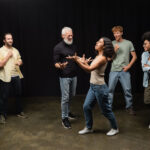Since the pandemic, virtual meetings and conferences have become as ordinary as a splash of oat milk in your coffee. Working from home is on the rise and doesn’t appear to be stopping anytime soon, considering that 98% of remote workers say they prefer to continue remotely.
As a result, you’re expected to stay camera-ready and communicate with the ease of an actor in Zoom meetings and video conferences that can significantly impact your career. But regardless of how common they are, virtual meetings differ from real life in myriad ways.
“For many, the minute the camera is in front of us, we imagine our face is broadcasting live for all of the world to laugh at, with popcorn, in real time,” says San Diego-based on-camera performance coach Michelle Kennedy. “The power of that lens changes us. It brings a unique set of nerves and insecurity that only preparation can help reduce,” Kennedy adds.
Public speaking is already a common fear. Couple that with a camera and you have a cocktail of worry and fear with a twist of anxiety.
Meeting with fewer people doesn’t make it any easier. “One pair of eyes can be more intimidating than 60,” says Kennedy. This is why prep time ought to be the same whether you’re meeting with several people or one individual on your video call.
Read on for tips to overcome Zoom anxiety and feel more at ease on camera.
1. Rehearse and learn your own body language
Unless you’re a public personality, chances are you don’t realize how you come across on camera. To gain perspective, Kennedy recommends videoing yourself and then watching your performance with someone you trust to “become aware of your body language and any distracting habits or crutch phrases you might be overdoing on camera.”
The process “will help both of you to pick out any distracting on-camera habits, like overly active hand gestures or saying, ‘You see what I mean?’ after every sentence,” she explains. Many people unknowingly “completely change their persona on camera… and you won’t know if you are one of them until you watch and listen to yourself with someone who can lovingly point out what you might not see.”
2. Warm up mentally and physically
Tempted to forgo prep and wing it? Keep in mind that knowledge doesn’t automatically translate virtually—according to Kennedy, “the camera can eviscerate knowledge in a matter of seconds.” In case you lose your train of thought, Kennedy suggests having “your notes or bullet points either on the desk in front of you or taped to your computer screen or phone. That way, if a crucial thought leaves your head and you blank on what you wanted to say, you can take a deep breath, quickly glance at your notes, and pick right back up again.”
Nervous energy can actually provide some benefits, especially when you’re excited. If you were an actor, you might channel it into your performance. Most virtual meetings involve sitting in one place for a prolonged period, which gives undirected energy a chance to result in unwanted movements or speech patterns.
Try a centering exercise to release the energy from Zoom anxiety in a constructive way. First, stand up with your bare feet flat on the floor. Give your whole body a gentle shake to release tension. Then, stretch your arms overhead and slowly lower them to your sides. Envision an invisible thread aligning your spine. Spread your toes and feel grounded from the bottom of your feet upward. Close your eyes, relax your breath and tell yourself, “I am comfortable in my own skin. I am exactly where I want to be. I am calm and centered.”
To deepen your mind-body well-being, you can also try Tadasana (Mountain Pose) via these instructions from Yoga Journal.
3. Keep your look simple
In order to connect with your audience, or even with just one person, “sit up straight when you are on camera, bring expression to your face and make sure it is not frozen… smile, emote and react the way you would if you were sitting with someone you care about,” Kennedy advises.
As for wardrobe, “it is best to avoid busy clothing patterns and loud jewelry on camera because they tend to distract the viewer away from your message,” she adds. You can still bring a personal flair to your appearance, but keep your look as simple as possible. Kennedy adds that “lighting is your best friend. Wherever it is coming from, it needs to be on your face and not blazing in from a window behind your back.”
4. Embrace your mistakes
It’s natural to be worried about saying or doing the wrong thing. Mistakes are inevitable.
“Sometimes, people feel the need to overly apologize or make jokes about how they messed up,” Kennedy explains. “This is distracting, though, and breaks your connection with the audience, who was already hooked into your flow.”
Instead, correct mistakes immediately and move on. According to Kennedy, it’s all right to “bring levity into the moment, but a true professional will keep going, and your audience will likely move on with you and forget it happened.”
5. Hone your listening skills
The most charismatic actors are also adept listeners. They focus on the present, aware of what is and isn’t being said, as well as nonverbal cues. Everyone wants to be heard. Likewise, remember to take the focus off yourself. Engage your curiosity and be open to discovery.
Enhance your listening skills by practicing this sensory exercise in any setting: Sit comfortably and relax your breathing. Close your eyes and bring all your awareness to your auditory sense. Notice all you hear without judgment. What sounds initially surface? Go deeper to discover what’s beneath those sounds. Let your listening run out as far and wide as you can. Notice the quietest rustles. Rest in this awareness as you breathe, and then gently open your eyes and attune to your environment.
6. Create inner calm
Mindful breathing practices can ease your Zoom anxiety and create inner calm. Rev. Connie L. Habash, a yoga instructor and family therapist, suggests breathing through your nose and “focus[ing] on the exhalation,” as it “turns on the relaxation response in the body.” She adds that you should “aim for four counts for the inhalation and six to eight counts for the exhalation.” Or you can “take a deep breath in and then allow the breath to empty out through the mouth with an enjoyable sigh… do this a few times and allow yourself to relax into the moment with each exhalation. Let go of stress and anxiety as you let out that sigh.”
Habash also suggests becoming mindful of the camera as an object, even if it’s in your computer or phone. Envision it as a “loving friend witnessing your conversation and focus your mindful awareness on being as fully present as you can with the person interviewing you—or with the interviewee, if it is your video—as you can. Trust that you have your safe, supportive, friendly witness of the camera at your side to bring out your best.”
7. Remember to have fun
When it comes to developing your on-camera presence, preparation is crucial. Be careful not to consume heavy or sugary meals or caffeinated beverages shortly before a virtual meeting. Aim for healthy proteins and good fats, which promote energy and focus. Once the online meeting is in progress, listen intently and be curious and kind to yourself. Allow room for spontaneity.
When you become accustomed to interacting on camera, you give your world a chance to expand. Enjoy the collaborative process that begins with virtual meetings, just as it does in person.
Photo by Chay_Tee/Courtesy of Shutterstock.com










